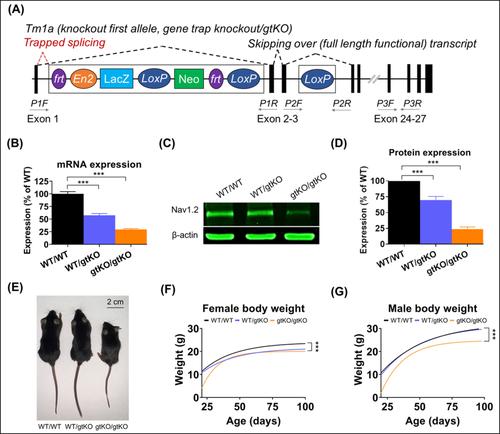当前位置:
X-MOL 学术
›
Genes Brain Behav.
›
论文详情
Our official English website, www.x-mol.net, welcomes your
feedback! (Note: you will need to create a separate account there.)
Generation and basic characterization of a gene‐trap knockout mouse model of Scn2a with a substantial reduction of voltage‐gated sodium channel Nav1.2 expression
Genes, Brain and Behavior ( IF 2.4 ) Pub Date : 2020-12-25 , DOI: 10.1111/gbb.12725 Muriel Eaton 1, 2 , Jingliang Zhang 1, 2 , Zhixiong Ma 1, 2 , Anthony C Park 1, 2 , Emma Lietzke 1, 2 , Chloé M Romero 1, 2 , Yushuang Liu 1, 2 , Emily R Coleman 1, 2 , Xiaoling Chen 1, 2 , Tiange Xiao 1, 2 , Zhefu Que 1, 2 , Shirong Lai 1, 2 , Jiaxiang Wu 1, 2 , Ji Hea Lee 1, 2 , Sophia Palant 1, 2 , Huynhvi P Nguyen 1, 2 , Zhuo Huang 3 , William C Skarnes 4 , Wendy A Koss 2, 5 , Yang Yang 1, 2
Genes, Brain and Behavior ( IF 2.4 ) Pub Date : 2020-12-25 , DOI: 10.1111/gbb.12725 Muriel Eaton 1, 2 , Jingliang Zhang 1, 2 , Zhixiong Ma 1, 2 , Anthony C Park 1, 2 , Emma Lietzke 1, 2 , Chloé M Romero 1, 2 , Yushuang Liu 1, 2 , Emily R Coleman 1, 2 , Xiaoling Chen 1, 2 , Tiange Xiao 1, 2 , Zhefu Que 1, 2 , Shirong Lai 1, 2 , Jiaxiang Wu 1, 2 , Ji Hea Lee 1, 2 , Sophia Palant 1, 2 , Huynhvi P Nguyen 1, 2 , Zhuo Huang 3 , William C Skarnes 4 , Wendy A Koss 2, 5 , Yang Yang 1, 2
Affiliation

|
Large‐scale genetic studies revealed SCN2A as one of the most frequently mutated genes in patients with neurodevelopmental disorders. SCN2A encodes for the voltage‐gated sodium channel isoform 1.2 (Nav1.2) expressed in the neurons of the central nervous system. Homozygous knockout (null) of Scn2a in mice is perinatal lethal, whereas heterozygous knockout of Scn2a (Scn2a+/−) results in mild behavior abnormalities. The Nav1.2 expression level in Scn2a+/− mice is reported to be around 50–60% of the wild‐type (WT) level, which indicates that a close to 50% reduction of Nav1.2 expression may not be sufficient to lead to major behavioral phenotypes in mice. To overcome this barrier, we characterized a novel mouse model of severe Scn2a deficiency using a targeted gene‐trap knockout (gtKO) strategy. This approach produces viable homozygous mice (Scn2agtKO/gtKO) that can survive to adulthood, with about a quarter of Nav1.2 expression compared to WT mice. Innate behaviors like nesting and mating were profoundly disrupted in Scn2agtKO/gtKO mice. Notably, Scn2agtKO/gtKO mice have a significantly decreased center duration compared to WT in the open field test, suggesting anxiety‐like behaviors in a novel, open space. These mice also have decreased thermal and cold tolerance. Additionally, Scn2agtKO/gtKO mice have increased fix‐pattern exploration in the novel object exploration test and a slight increase in grooming, indicating a detectable level of repetitive behaviors. They bury little to no marbles and have decreased interaction with novel objects. These Scn2a gene‐trap knockout mice thus provide a unique model to study pathophysiology associated with severe Scn2a deficiency.
中文翻译:

Scn2a 基因陷阱敲除小鼠模型的生成和基本表征,电压门控钠通道 Nav1.2 表达显着减少
大规模遗传学研究表明, SCN2A是神经发育障碍患者中最常见的突变基因之一。 SCN2A编码在中枢神经系统神经元中表达的电压门控钠通道亚型 1.2 (Na v 1.2)。小鼠中Scn2a的纯合敲除(无效)是围产期致死的,而Scn2a的杂合敲除 ( Scn2a +/- ) 会导致轻微的行为异常。据报道, Scn2a +/-小鼠中的 Na v 1.2 表达水平约为野生型 (WT) 水平的 50-60%,这表明 Na v 1.2 表达减少近 50% 可能不足以导致小鼠的主要行为表型。为了克服这一障碍,我们使用靶向基因陷阱敲除(gtKO)策略表征了严重Scn2a缺陷的新型小鼠模型。这种方法产生了可存活的纯合小鼠 ( Scn2a gtKO/gtKO ),它们可以存活到成年,与 WT 小鼠相比,Na v 1.2 表达量约为 1/4。 Scn2a gtKO/gtKO小鼠的筑巢和交配等先天行为受到严重破坏。值得注意的是,在开放场地测试中,与 WT 相比, Scn2a gtKO/gtKO小鼠的中心持续时间显着缩短,这表明在新的开放空间中存在类似焦虑的行为。这些小鼠的耐热性和耐冷性也降低。 此外, Scn2a gtKO/gtKO小鼠在新物体探索测试中增加了固定模式探索,并且梳理行为略有增加,表明可检测到重复行为水平。他们很少甚至不埋弹珠,并且与新奇物体的互动也减少了。因此,这些Scn2a基因陷阱敲除小鼠提供了一个独特的模型来研究与严重Scn2a缺陷相关的病理生理学。
更新日期:2020-12-25
中文翻译:

Scn2a 基因陷阱敲除小鼠模型的生成和基本表征,电压门控钠通道 Nav1.2 表达显着减少
大规模遗传学研究表明, SCN2A是神经发育障碍患者中最常见的突变基因之一。 SCN2A编码在中枢神经系统神经元中表达的电压门控钠通道亚型 1.2 (Na v 1.2)。小鼠中Scn2a的纯合敲除(无效)是围产期致死的,而Scn2a的杂合敲除 ( Scn2a +/- ) 会导致轻微的行为异常。据报道, Scn2a +/-小鼠中的 Na v 1.2 表达水平约为野生型 (WT) 水平的 50-60%,这表明 Na v 1.2 表达减少近 50% 可能不足以导致小鼠的主要行为表型。为了克服这一障碍,我们使用靶向基因陷阱敲除(gtKO)策略表征了严重Scn2a缺陷的新型小鼠模型。这种方法产生了可存活的纯合小鼠 ( Scn2a gtKO/gtKO ),它们可以存活到成年,与 WT 小鼠相比,Na v 1.2 表达量约为 1/4。 Scn2a gtKO/gtKO小鼠的筑巢和交配等先天行为受到严重破坏。值得注意的是,在开放场地测试中,与 WT 相比, Scn2a gtKO/gtKO小鼠的中心持续时间显着缩短,这表明在新的开放空间中存在类似焦虑的行为。这些小鼠的耐热性和耐冷性也降低。 此外, Scn2a gtKO/gtKO小鼠在新物体探索测试中增加了固定模式探索,并且梳理行为略有增加,表明可检测到重复行为水平。他们很少甚至不埋弹珠,并且与新奇物体的互动也减少了。因此,这些Scn2a基因陷阱敲除小鼠提供了一个独特的模型来研究与严重Scn2a缺陷相关的病理生理学。











































 京公网安备 11010802027423号
京公网安备 11010802027423号